
The Falkland Islands are a British overseas territory and, as such, rely on the United Kingdom for the guarantee of their security. The other UK territories in the South Atlantic, South Georgia and the South Sandwich Islands, fall under the protection of British Forces South Atlantic Islands (BFSAI), formerly known as British Forces Falkland Islands (BFFI), which includes commitments from the British Army, Royal Air Force and Royal Navy. They are headed by the Commander, British Forces South Atlantic Islands (CBFSAI), a brigadier-equivalent appointment that rotates among all three services.

The Type 23 frigate or Duke class is a class of frigates built for the United Kingdom's Royal Navy. The ships are named after British Dukes, thus leading to the class being commonly known as the Duke class. The first Type 23, HMS Norfolk, was commissioned in 1989, and the sixteenth, HMS St Albans was commissioned in June 2002. They form the core of the Royal Navy's destroyer and frigate fleet and serve alongside the Type 45 destroyers. They were designed for anti-submarine warfare, but have been used for a range of uses. Ten Type 23 frigates remain in service with the Royal Navy, with three vessels having been sold to the Chilean Navy, one being retired in 2021, and two being retired in 2023.

HMS Liverpool was a Type 42 destroyer of the Royal Navy. She was built by Cammell Laird in Birkenhead and launched on 25 September 1980 by Lady Strathcona, wife of Euan Howard, the then Minister of State for Defence. Liverpool was the last Type 42 Batch 2 in service.

The Type 45 destroyer, also known as the D or Daring class, is a class of six guided-missile destroyers built for the United Kingdom's Royal Navy in the early 21st century. The class is primarily designed for anti-aircraft and anti-missile warfare and is built around the PAAMS air-defence system using the SAMPSON Active electronically scanned array (AESA) and the S1850M long-range radars. The first three destroyers were assembled by BAE Systems Surface Fleet Solutions from partially prefabricated "blocks" built at different shipyards; the remaining three were built by BAE Systems Maritime – Naval Ships. The first ship in the Daring class, HMS Daring, was launched on 1 February 2006 and commissioned on 23 July 2009.

HMS Lancaster is a Duke-class Type 23 frigate of the Royal Navy, launched by Queen Elizabeth II on 24 May 1990. The ship is known as "The Queen's Frigate", the Duke of Lancaster being a subsidiary title of the Sovereign. Being the third ship in the Type 23 class, Lancaster was originally allocated the pennant number F232 until it was noted that the 232 is the Royal Navy report form for groundings and collisions and therefore considered unlucky. She is one of the few ships left in the fleet with some female officers but mess decks which are men-only. It is quite common when she has returned from long operations that she is flown over by the Avro Lancaster bomber which is part of the Battle of Britain Memorial Flight based at RAF Coningsby.
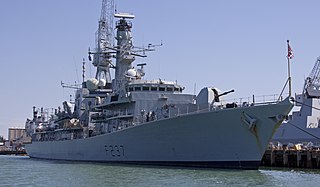
HMS Westminster is a Type 23 frigate of the Royal Navy, and the second ship to bear the name. She was launched on 4 February 1992 and named after the Dukedom of Westminster.
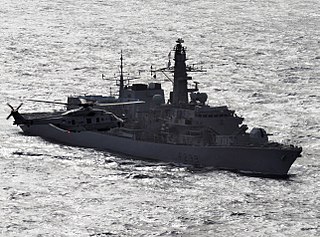
HMS Richmond is a Type 23 frigate of the Royal Navy. She was launched on 6 April 1993 by Lady Hill-Norton, wife of the late Admiral of the Fleet The Lord Hill-Norton, and was the last warship to be built by Swan Hunter Shipbuilders. She sailed from the builders on the River Tyne in November 1994. She is named for the Dukedom of Richmond.

HMS Somerset is a Type 23 frigate of the Royal Navy. She is the eleventh ship of the class to join the fleet since 1989. She was built by Yarrow Shipbuilders Ltd on the River Clyde, in Scotland and was launched in June 1994 by Lady Elspeth Layard, wife of then 2nd Sea Lord Admiral and Commander-in-Chief Naval Home Command Admiral Sir Michael Layard. She entered service in 1996. Lady Layard is the ship's sponsor. She is named after the Dukedom of Somerset.

HMS Sutherland is a Type 23 frigate of the British Royal Navy. She is the thirteenth ship in the Duke class of frigates and is the third ship to bear the name, more than 200 years since the name was last used.
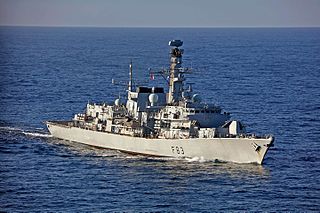
HMS St Albans is a Type 23 frigate of the Royal Navy. She is the sixth ship to bear the name and is the sixteenth and final ship in the 'Duke' class of frigates. She is based in Devonport, Plymouth.
HMS Gloucester was a Batch 3 Type 42 destroyer of the Royal Navy, built by Vosper Thorneycroft at Woolston, Southampton and launched on 2 November 1982 by The Duchess of Gloucester. Gloucester was one of the modified last four of the class to be built, having a lengthened hull design giving better seakeeping qualities, greater endurance and an external 'strake' to counter longitudinal cracking, seen on earlier ships of the type. The flight deck recognition letters worn by Gloucester were GC, and her international callsign was GBBF.

HMS Bristol (D23) was a Type 82 destroyer, the only vessel of her class to be built for the Royal Navy. Bristol was intended to be the first of a class of large destroyers to escort the CVA-01 aircraft carriers projected to come into service in the early 1970s but the rest of the class and the CVA-01 carriers were cancelled as a result of the 1966 Defence White Paper which cut defence spending.

Standing Royal Navy deployments is a list of operations and commitments undertaken by the United Kingdom's Royal Navy on a worldwide basis. The following list details these commitments and deployments sorted by region and in alphabetical order. Routine deployments made by the Navy's nuclear-powered submarines and their location of operations is classified.
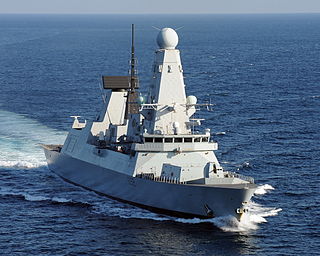
HMS Daring is the lead ship of the Type 45 or Daring-class air-defence destroyers built for the Royal Navy, and the seventh ship to hold that name. She was launched in 2006 on the Clyde and conducted contractor's sea trials during 2007 and 2008. She was handed over to the Royal Navy in December 2008, entered her base port of Portsmouth for the first time in January 2009 and was formally commissioned on 23 July 2009. As the lead ship of the first destroyer class built for the Royal Navy since the Type 42 in the 1970s, she has attracted significant media and public attention. Her name, crest and motto are a reference to the Roman youth Gaius Mucius Scaevola, famed for his bravery.

HMS Diamond is the third ship of the Type 45 or Daring-class air-defence guided missile destroyers built for the Royal Navy. She was launched in 2007, and completed her contractor's sea trials and arrived at her base port in 2010. Diamond formally entered service in 2011.

HMS Dragon is the fourth ship of the Type 45 or Daring-class air-defence destroyers built for the Royal Navy. She was launched in November 2008 and commissioned on 20 April 2012.

HMS Defender is the fifth of the Type 45 or Daring-class air-defence destroyers built for the Royal Navy. She is the eighth ship to bear the name. Construction of Defender began in 2006, and she was launched in 2009. The ship completed her first sea trials in October and November 2011, and was commissioned during March 2013.

HMS Duncan is the sixth and last of the Type 45 or Daring-class air-defence destroyers built for the Royal Navy and launched in 2010. Duncan is named after Adam Duncan, 1st Viscount Duncan, who defeated the Dutch fleet at the Battle of Camperdown on 11 October 1797. The destroyer has served in the Mediterranean, Black, and Caribbean Seas, and in 2019 was deployed to the Persian Gulf in response to increased tensions with Iran in the region.
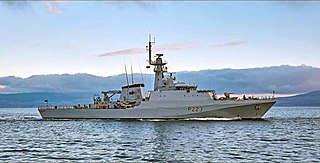
HMS Medway is a Batch 2 River-class offshore patrol vessel for the Royal Navy. Named after the River Medway in Kent, she was the second Batch 2 River-class vessel to be commissioned and is assigned long-term as Royal Navy guardship in the Caribbean.


















